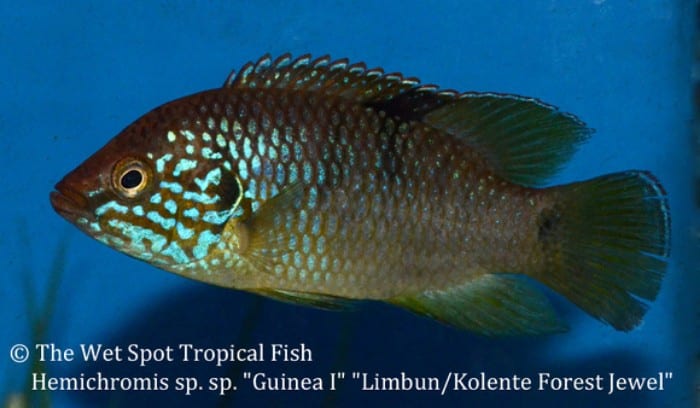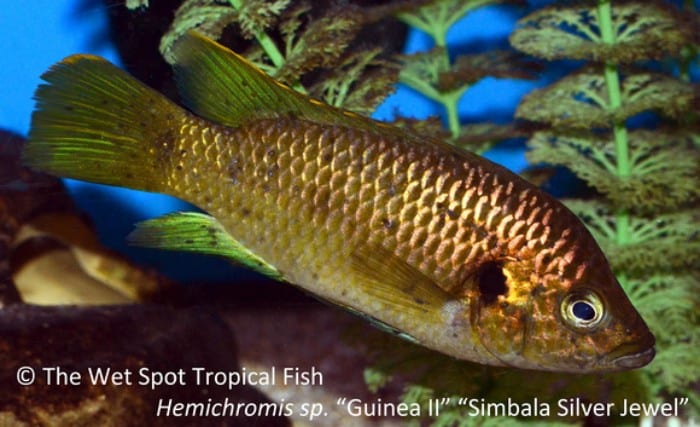He’s Her Lobster
He’s Her Lobster
Pop culture has taught us through masterpieces like “March of the Penguins” or “The Lion King” that humans feel connected to other animals that form lasting pair bonds. This mating strategy is also found in many freshwater fish, most notably among cichlids. Not only is the idea of watching a romance unfold in your own tank enticing, but most pair-bonding cichlids rely heavily on beautiful coloration to attract mates, which is always a desired trait to the tropical aquarist hobbyist. These behaviors and characteristics often find origin within old world freshwater habitats, in which a few of our favorites include Congochromis cf. Sabinae, Thoracochromis demeusii, and Hemichromis sp. “Guinea I” and “Guinea II”.
Scientific NameCongochromis cf. sabinae
Common NameNone
Temperature / pH75 to 81°F / 4.0 to 6.0 pH
Native LocationNortheastern Congo
Preferred DietOmnivorous
With golden faces peaking, dark black striping, and read and white tipped fins, C. sabinae males search for their soul mates and territory to defend where they may raise their young. Described from northeastern Congo regions, these pairs are most often found in forested habitats with thick marginal vegetation, and tannin-stained waters from decaying litter. Optimal tank setup would include soft, sandy substrate, plentiful aquatic vegetation, floating plants, driftwood, caves for spawning, plenty of shady refuges, and dried leaf litter. Reaching about 2.5 inches in length, males tend to be territorial, and aquarium size for a breeding pair should be no smaller than 60 by 30 cm. These cichlids can be maintained in well established community tanks alongside peaceful, schooling fish, though no more than 1 pair should housed in a single tank to avoid aggression unless the aquarium is large enough to delineate multiple spawning territories. In the wild, these fish mostly consume detritus and aquatic invertebrates and while in captivity, they can be fed fine-grade prepared foods with a large vegetal component like spirulina, supplemented by live and frozen fare like bloodworm, daphnia, or brine to encourage best coloration, which is exhibited during breeding. Waters should be maintained with temperatures between 75 and 81°F, pH of 4.0 to 6.0, and very soft waters with hardness of 0 to 54 ppm.
Scientific NameThoracochromis demeusii
Common NameBlood Throat Cichlid
Temperature / pH75 to 83°F / 6.0 to 7.5 pH
Native LocationLower Congo
Preferred DietSmall invertebrates
Found a bit lower in the Congo, T. demeusii males woo females with prominent courtship humps, and golden-orange throats. These cichlids are incredibly beautiful with greenish-gold bodies, blue accents, a dark black cheek spot, and orange-spotted blue fins. Quite rare to the aquarium hobby, little is known about optimal tank setup, though their natural biotope includes soft, sandy substrate, driftwood roots and branches, dim lighting, and plentiful aquatic vegetation. A bit less romantic than some pair-bonding counterparts from their region, males form dominance hierarchies, and multiple hiding places should be provided to maintain peace. A single male should be kept either with a few females to reduce male-on-female harassment. In captivity, these cichlids will accept most high quality flake and pellet, and for best coloration should be fed regular meals of bloodworm, daphnia, cyclops, and filamentous algae. Optimal water conditions would have temperatures between 75 and 83°F, pH of 6.0 to 7.5, and hardness of 35 to 107 ppm.
Scientific NameHemichromis sp. “Guinea I”
Common NameKolente Forest Jewel
Temperature / pH72 to 82°F / 6.0 to 7.8 pH
Native LocationWest Africa
Preferred DietOmnivorous
Some of the most popular pair-bonding African cichlids are Jewel cichlids of the genus Hemichromis. Resembling shining gems as their common names describe, there are 11 known species with greatly different appearances between habitats of creeks, streams, rivers, and lakes of West Africa. Found in Guinea, 2 Hemichromis varieties referred to as H. sp. “Guinea I”, and H. sp. “Guinea II” are boisterous and charismatic pair bonders. More commonly referred to as Kolente Forest Jewels, and Simbala Silver Jewels respectively, Guinea I’s are orangey in coloration with shimmering turquoise markings and black striping, while Guinea II’s are mostly silver with copper markings and green fins. These species are ideal for the seasoned aquarist looking to set up species specific tanks. Several young individuals can be kept together, and pairs can be moved to mature breeding tanks for spawning. Tank setup should include many hiding places, driftwood, strong-rooted or potted plants, and plentiful swimming space. They can be fed a variety of flakes and pellets, though regular supplementation of live and frozen fare enhances coloration. They should also be fed a high vegetal component diets with offerings of spirulina or blanched spinach. Optimal waters have temperatures of 72 to 82°F, pH of 6.0 to 7.8, and hardness between 28 and 128 ppm.
Scientific NameHemichromis sp. “Guinea II”
Common NameSimbala Silver Jewel
Temperature / pH72 to 82°F / 6.0 to 7.8 pH
Native LocationWest Africa
Preferred DietOmnivorous
We all remember that Ross is Rachel’s lobster, and desire to find and hold on to our own. Watch another great love story unfold in your tank full of tumultuous courtship, and give the Wet Spot a call to find the perfect pair!



